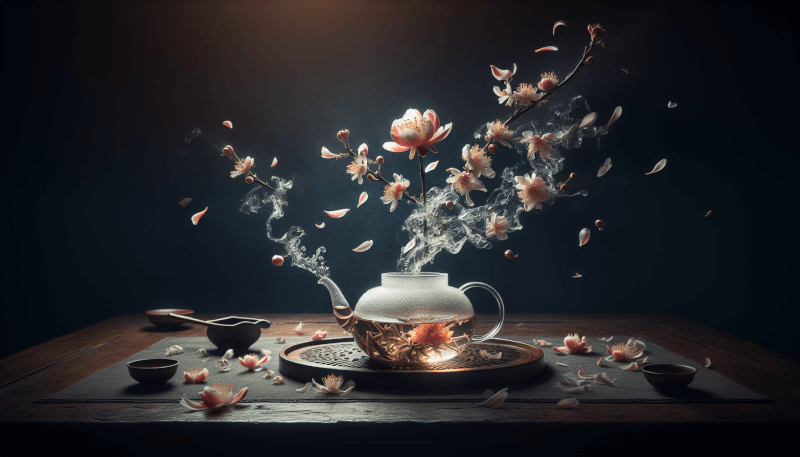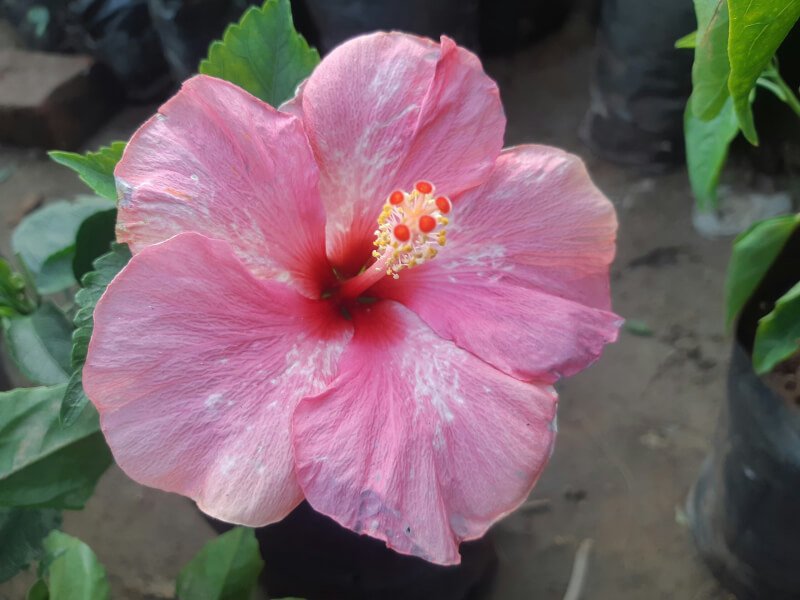Get ready to immerse yourself in the enchanting world of blooming tea brewing. In this article, we will take you on a delightful journey through the art of creating visually stunning and delicious tea experiences. From the intricately hand-tied tea balls unfurling in hot water to the mesmerizing aromas and flavors that blossom with each sip, blooming tea brewing is a true feast for the senses. So, grab a cup of your favorite tea, sit back, and let us transport you to a world where beauty and taste intertwine in perfect harmony.
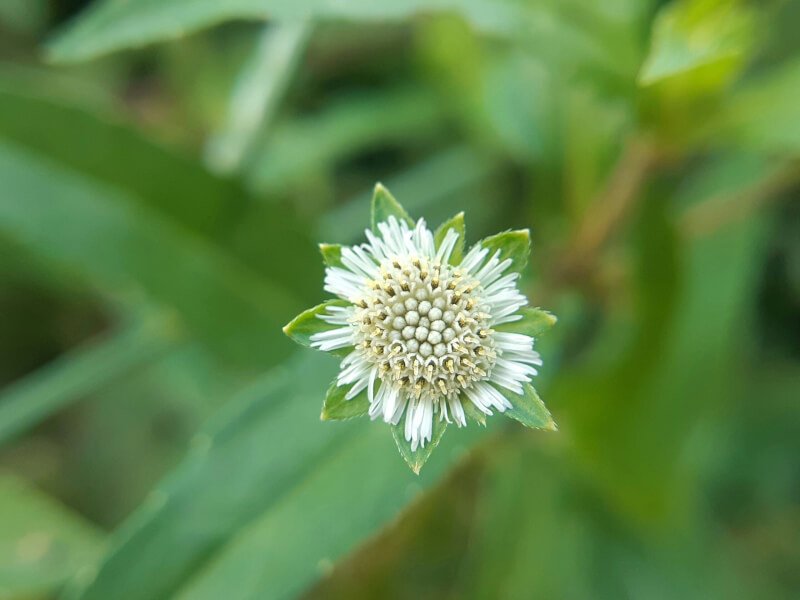
The Origin and History of Blooming Tea
The Discovery of Blooming Tea
The enchanting and mesmerizing art of blooming tea can be traced back to ancient China. Legend has it that during the Tang Dynasty, a tea farmer stumbled upon this captivating phenomenon by accident. While drying tea leaves outdoors, he inadvertently left them overnight, only to wake up the next morning to a delightful surprise. The fallen flowers from nearby plants had beautifully intertwined with the tea leaves, creating a stunning display of nature’s harmony. This accidental discovery marked the birth of blooming tea, a tea that not only delighted the senses but also became an integral part of cultural rituals and ceremonies.
The Popularity of Blooming Tea in Ancient China
As blooming tea became more widely known and appreciated, it quickly gained popularity in ancient China. Emperors and nobles began to embrace this art form, and blooming tea became an integral part of their lavish lifestyles. The delicate tea buds were handpicked with utmost care and combined with vibrant flowers and herbs, creating exquisite displays when the tea steeped. The artistry behind blooming tea brewing was considered a symbol of sophistication and elegance, often treasured during ritualistic tea ceremonies. It became an expression of art, culture, and social status.
Blooming Tea in Modern Times
The ancient art of blooming tea brewing has transcended time and continues to captivate tea enthusiasts around the world. While it still holds a special place in Chinese culture, blooming tea has gained global recognition as a unique and visually stunning tea-drinking experience. In modern times, blooming tea has become more accessible, allowing people from different corners of the world to incorporate this enchanting ritual into their daily lives. As the popularity of blooming tea grows, it evolves, with new varieties and flavors constantly being introduced to satisfy the diverse tastes of tea lovers everywhere.
Understanding the Ingredients
The Base Tea Leaves
Every blooming tea ball begins with a base of high-quality, whole leaf tea. Often, the base tea used is green tea or white tea, known for their delicate flavors and ability to blend harmoniously with other ingredients. These base teas are specially selected for their ability to unfurl and showcase the blooming process to its fullest.
The Flowers and Herbs Used in Blooming Tea
What sets blooming tea apart from other teas is its infusion of vibrant flowers and aromatic herbs. Some of the most commonly used flowers and herbs in blooming tea include jasmine, rose, chrysanthemum, and lavender. Each ingredient not only adds a distinct flavor but also contributes to the visual aspect of the tea. These flowers and herbs are meticulously selected and hand-tied with the base tea leaves, resulting in a stunning display once steeped.
The Importance of Quality Ingredients
To truly appreciate the artistry of blooming tea brewing, it is crucial to use high-quality ingredients. The base tea leaves should be sourced from reputable tea gardens, ensuring their freshness and purity. Equally important is the selection of flowers and herbs, which should be free from pesticides and grown in optimal conditions. Using fresh, high-quality ingredients ensures that the flavors and aromas are at their best, creating a truly delightful tea-drinking experience.
Preparing to Brew Blooming Tea
Gathering the Necessary Tools and Equipment
Brewing blooming tea requires a few essential tools and equipment to ensure a successful and enjoyable experience. These include a glass teapot or a clear teacup to fully appreciate the beauty of the blooming process, a kettle to heat water, a tea infuser or strainer for precise pouring, and a timer to track steeping time. Having the right tools at hand eliminates any obstacles and allows you to fully immerse yourself in the art of blooming tea brewing.
Choosing the Right Teapot
When selecting a teapot for blooming tea brewing, opt for a glass teapot that allows you to witness the unfolding wonders of the blooming tea ball. The transparency of the glass teapot enhances the visual spectacle and allows you to appreciate the intricate details as the tea magically blooms. Additionally, a glass teapot is also ideal for showcasing the vibrant colors of the flowers and herbs used in blooming tea.
Measuring the Water and Tea
Achieving the perfect balance of water and tea is crucial for brewing blooming tea. To achieve the optimal flavor, use one blooming tea ball per teapot, or adjust the amount according to personal preference. As for the water, measure approximately 200ml per teapot, allowing room for the tea ball to bloom fully. It is essential to follow the recommended measurements to ensure a consistent and enjoyable brewing experience.
Heating the Water to the Right Temperature
Different types of tea require specific water temperatures for optimal brewing. For blooming tea, it is recommended to use water heated to around 185°F (85°C). Water that is too hot may result in a bitter taste, while water that is too cool may not fully extract the flavors from the tea leaves and flowers. Investing in a thermometer or electric kettle with temperature control can help ensure the water reaches the desired temperature for the perfect infusion.
The Art of Blooming Tea Brewing
Unfolding the Blooming Tea Ball
As you embark on the journey of blooming tea brewing, gently unwrap the blooming tea ball. The tightly bound leaves and flowers will start to reveal their hidden beauty. Take a moment to appreciate the craftsmanship and intricacy of the tea ball before placing it in the teapot.
Placing the Tea in the Teapot
Carefully place the unwrapped blooming tea ball in the center of the teapot. Position it delicately to allow room for the unfurling process. The teapot should ideally be no more than half full to ensure sufficient space for the tea to bloom and infuse properly.
Pouring the Hot Water over the Tea
With steady hands, pour the hot water over the blooming tea ball, allowing the magic to unfold. Take note not to pour the water directly onto the flowers and herbs to avoid damaging their delicate petals. The water should be poured slowly and evenly, covering the entire tea ball to ensure even extraction and the full expression of flavors.
Allowing the Tea to Steep and Bloom
Once the water is poured, let the blooming tea steep for approximately 3-5 minutes. The precise steeping time may vary depending on personal taste preferences and the specific blooming tea variety being brewed. Throughout the steeping process, pay close attention as the tea ball unfurls, unveiling its mesmerizing blossoms. Allow yourself to be captivated by the unfolding beauty and the enticing aroma that fills the air.
Admiring the Visual Spectacle
As the blooming tea fully unfurls, you will be treated to a captivating visual spectacle. The vibrant flowers and aromatic herbs will dance gracefully in the teapot, creating a mesmerizing display of colors and shapes. Take a moment to appreciate the artistry and craftsmanship that went into creating this beautiful work of nature.

Mastering the Brewing Techniques
Choosing the Right Water Temperature
The water temperature plays a crucial role in the brewing process, as it can greatly affect the flavors and aromas of the blooming tea. Experiment with different water temperatures to find the ideal balance that brings out the best in your chosen blooming tea variety. Generally, green and white teas are best brewed at lower temperatures, around 175-185°F (80-85°C), while black and oolong teas can handle slightly higher temperatures, around 195-205°F (90-96°C).
Timing the Steeping Process
Timing is everything when it comes to blooming tea brewing. The steeping time directly affects the flavors, strength, and balance of the tea. Start with the recommended steeping time provided by the tea manufacturer and adjust according to your personal taste preferences. Keep in mind that steeping too long may result in bitterness, while steeping too short may produce a weaker infusion. Fine-tuning the steeping time will ensure optimal flavor and a satisfying tea experience.
Experimenting with Different Steeping Times
Part of the joy of blooming tea brewing is the opportunity to explore and experiment with different steeping times. By adjusting the steeping time, you can unlock a variety of flavors and aromas hidden within the blooming tea ball. Try shorter steeping times for a milder taste or longer steeping times for a bolder, more robust flavor. Be adventurous and let your taste buds guide you in discovering your personal preference.
Understanding the Ideal Tea-to-Water Ratio
Finding the perfect tea-to-water ratio is essential for achieving a well-balanced and flavorful cup of blooming tea. While personal preferences may vary, a general guideline is to use one blooming tea ball per 200ml of water. However, feel free to adjust the ratio to suit your taste. Increasing the amount of tea will intensify the flavors, while decreasing the amount will result in a milder infusion. Take the time to experiment and find the perfect ratio that satisfies your palate.
Savoring the Flavors of Blooming Tea
The Delicate and Nuanced Taste of Blooming Tea
One of the delights of blooming tea lies in its delicate and nuanced taste. The combination of high-quality tea leaves, flowers, and herbs creates a well-balanced flavor profile that is both soothing and refreshing. When sipping blooming tea, expect subtle floral notes intertwined with the natural sweetness of the base tea. The flavors unfold gracefully with each sip, inviting you to savor the complexity and uniqueness of the brew.
Appreciating the Aroma
The aroma of blooming tea is as enchanting as its visual display. As the tea infuses and blooms, a fragrant bouquet fills the air, enveloping you in a sensory experience like no other. Breathe in deeply to appreciate the delicate floral notes that dance harmoniously with the earthy essence of the tea leaves. The aroma of blooming tea transports you to a tranquil oasis, offering a moment of relaxation and serenity.
Sipping and Savoring the Tea
When it comes to enjoying blooming tea, take your time to savor each sip. The flavors and aromas are best appreciated when you allow the tea to linger on your palate. Take small, mindful sips, allowing the brewed tea to coat your taste buds and reveal its intricacies. Notice how the tea evolves with each sip, releasing different flavors and sensations. Let the experience of blooming tea brewing unfold gently, sip by sip.
Pairing Blooming Tea with Food
Pairing blooming tea with food can elevate the taste experience and create delightful combinations. Due to its delicate flavors, blooming tea pairs well with light and subtly flavored dishes. Consider serving blooming tea with fruit salads, delicate pastries, or light seafood dishes to complement its nuanced taste. The subtle floral notes and gentle sweetness of blooming tea can enhance the flavors of the food, creating a harmonious balance on your taste buds.
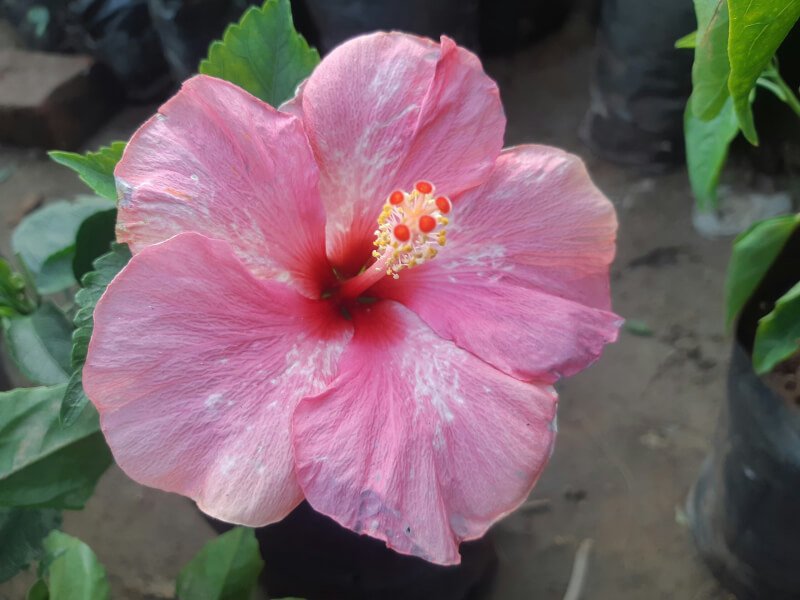
Storing and Preserving Blooming Tea
Proper Storage Techniques
To preserve the quality and flavors of blooming tea, proper storage is essential. Store blooming tea in an airtight container, away from moisture, light, and strong odors. Exposure to these elements can deteriorate the taste and fragrance of the tea over time. Additionally, it is advisable to store blooming tea separately from other teas to avoid flavor contamination.
Protecting the Tea from Moisture and Light
Moisture and light are the enemies of blooming tea, as they can cause the tea to lose its vibrant colors and flavors. Ensure that the storage container is tightly sealed to prevent any moisture from seeping in. Furthermore, store the container in a cool, dark place, such as a pantry or cupboard, away from direct sunlight. This will help maintain the tea’s freshness and preserve its natural beauty.
Extending the Shelf Life of Blooming Tea
Blooming tea is best enjoyed when it is fresh and vibrant. While its shelf life may vary depending on the quality of the tea and storage conditions, blooming tea can generally be stored for up to 12-18 months. To extend the shelf life of your blooming tea, consider vacuum-sealing the tea balls before storing them. This will help minimize exposure to air and further protect the tea’s flavors and aromas.
The Health Benefits of Blooming Tea
Antioxidant Properties
Like many other teas, blooming tea possesses potent antioxidant properties that can help protect the body against free radicals. These antioxidants, such as catechins and polyphenols, contribute to overall wellness and may help reduce the risk of chronic diseases. Adding blooming tea to your daily routine can be an excellent way to boost your antioxidant intake and promote a healthier lifestyle.
Aiding Digestion
Blooming tea, especially those made with herbal ingredients like chamomile and peppermint, can aid digestion and soothe an upset stomach. The natural compounds found in these herbs have been traditionally used to alleviate digestive discomfort, reduce bloating, and improve overall gut health. Enjoy a cup of blooming tea after a meal to aid digestion and promote a sense of well-being.
Boosting the Immune System
Blooming tea, with its combination of high-quality tea leaves and flowers, can provide a natural boost to the immune system. The antioxidants and bioactive compounds present in blooming tea can help strengthen the body’s defenses, protecting it against harmful pathogens and reducing the risk of infections. Regular consumption of blooming tea can support a healthy immune system and contribute to overall well-being.
Promoting Relaxation and Stress Relief
The act of brewing and savoring blooming tea can be a moment of tranquility amidst the hustle and bustle of daily life. The gentle aromas and flavors of blooming tea have a calming effect on the mind and body. The ritual of blooming tea brewing promotes relaxation and can be an effective way to unwind and alleviate stress. Take a moment for yourself, breathe in the soothing aroma, and let the tranquility of blooming tea envelop your senses.
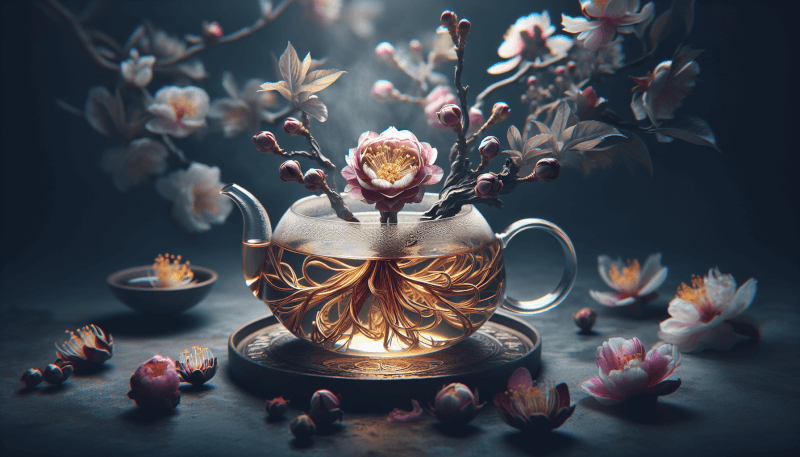
Exploring Different Varieties of Blooming Tea
Rose Blooming Tea
Rose blooming tea combines the delicate flavors of green or white tea with the elegant and alluring aroma of rose petals. This variety is known for its romantic appeal and the soothing properties associated with roses. The tea leaves blend harmoniously with the roses, resulting in a fragrant and visually stunning bloom. Rose blooming tea is a favorite choice for those seeking a romantic and enchanting tea-drinking experience.
Jasmine Blooming Tea
Jasmine blooming tea is a classic variety that has been cherished for centuries. The subtle sweetness of jasmine flowers intertwines gracefully with the gentle flavors of green or white tea, creating a perfectly balanced infusion. Jasmine blooming tea delights with its heavenly fragrance and captivating visual display. This variety is an excellent choice for those who appreciate the timeless elegance of jasmine.
Chrysanthemum Blooming Tea
Chrysanthemum blooming tea showcases the vibrant colors and delicate flavors of chrysanthemum flowers. It is revered for its herbal properties and is believed to have various health benefits. Chrysanthemum blooming tea offers a floral and refreshing taste, with a hint of sweetness reminiscent of the flower itself. This variety is a popular choice for those seeking a soothing and rejuvenating tea experience.
Lavender Blooming Tea
Lavender blooming tea infuses green or white tea with the calming and aromatic essence of lavender flowers. Known for its relaxing properties, lavender blooming tea offers a soothing tea-drinking experience. The floral notes of lavender blend harmoniously with the delicate flavors of the base tea, creating a gentle and enchanting brew. Lavender blooming tea is a delightful choice for those looking to unwind and indulge in moments of serenity.
The Ritual and Culture of Blooming Tea
Blooming Tea Ceremonies
Blooming tea brewing is often accompanied by special ceremonies that celebrate the beauty and artistry of this ancient tradition. In China, blooming tea ceremonies are steeped in history and symbolism. Each step of the brewing process is carefully performed with grace and precision, from the selection of the teapot to the pouring of the water. These ceremonies serve as an opportunity to connect with nature, appreciate the craftsmanship, and foster a sense of mindfulness.
The Symbolism Behind Blooming Tea
Blooming tea holds deep symbolism and meaning in various cultures. In Chinese culture, the blooming tea ball represents beauty, purity, and the cyclical nature of life. The unfolding of the tea leaves and flowers mirrors the journey of growth and transformation. Blooming tea is often associated with new beginnings, good fortune, and spiritual harmony. The act of brewing and savoring blooming tea is a way to connect with these symbolic meanings and embrace the beauty of life’s cycles.
Blooming Tea in Different Cultures
While blooming tea is deeply rooted in Chinese culture, its popularity has spread to different parts of the world, each embracing it in their unique way. In Japan, blooming tea is often served during traditional tea ceremonies, where every gesture and movement holds profound significance. In Morocco, a similar concept known as Moroccan flowering tea is enjoyed, featuring delicate flowers that bloom inside a teapot. No matter the culture, blooming tea serves as a bridge that unites people through the shared appreciation of art, culture, and the beauty found in nature.
In conclusion, the art of blooming tea brewing is a captivating and enchanting experience that has withstood the test of time. From its humble origins in ancient China to its global popularity in modern times, blooming tea continues to bewitch tea enthusiasts with its visual spectacle, delicate flavors, and symbolic meanings. Understanding the ingredients, preparing for brewing, and mastering the techniques allow one to fully appreciate the beauty and craftsmanship behind blooming tea. With its many health benefits, diverse varieties, and rich cultural heritage, blooming tea invites us to slow down, savor the moment, and immerse ourselves in a world of tranquility and harmony.
